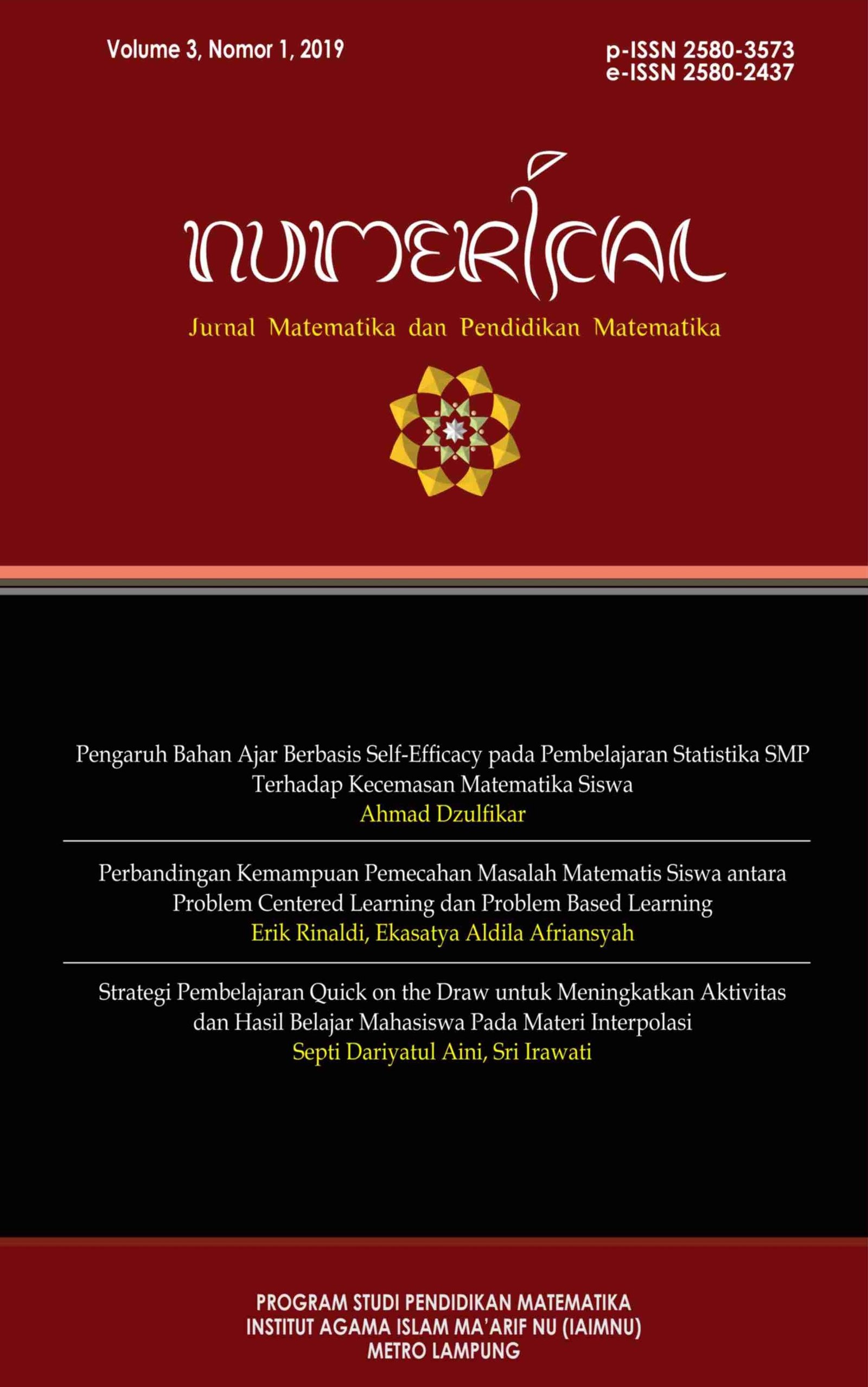Pengembangan Bahan Ajar Aljabar Linear dengan Menggunakan Model Pembelajaran Matematika Knisley
DOI:
https://doi.org/10.25217/numerical.v3i1.417Keywords:
Knisley's Model; Module; Linear Transformation.Abstract
This article aimed to find out the development of teaching materials in the form of modules by using Knisley's mathematical learning model on the subject of decent, interesting, and effective linear transformation used in lectures in Linear Algebra. The test subjects in this study were third semester students of Raden Intan Lampung State Islamic University. This research method is Research and Development (R & D) that uses the ADDIE Model (Analysis, Design, Development, Implementation, and Evaluation). The results of the expert assessment are feasible to use with an average score of 3.00 from material experts and 3.08 from media experts. The response of students in small group trials is interesting with an average score of 2.92, whereas in the trial of a large group the criteria are very interesting with an average score of 3.27. The results of the n-gain calculation at the pretest and posttest are 0.70 included in the high effectiveness category. Therefore, it can be concluded that the linear transformation module using Knisley's mathematics learning model is categorized as feasible, interesting, and effective to be used in Linear Algebra lectures
References
B. Luneto, “Profesionalisme Guru Dalam Perspektif Islam,” J. Manaj. Pendidik. Islam, vol. 3, no. 1, hlm. 38–49, 2015.
B. Ed. Course, Basic in Education. New Delhi: National Council of Educational Research and Training, 2014.
H. B. Uno dan N. Lamatenggo, Landasan Pendidikan. Jakarta: Bumi Aksara, 2017.
M. Hariyani, “Strategi Pembelajaran Matematika Madrasah Ibtidaiyah Berintegrasi Nilai-nilai Islam,” Menara, vol. 12, hlm. 151, 2013.
K. L. Purwanti, “Perbedaan Gender Terhadap Kemampuan Otak Kanan Pada Siswa Kelas I,” SAWWA, vol. 9, hlm. 107–122, 2013.
E. Dedy, E. Mulyana, E. Sudihartinih, dan U. P. Indonesia, “Pengembangan Bahan Ajar Kalkulus Vektor Berdasarkan Model Pembelajaran Matematika Knisley Sebagai Upaya Meningkatkan Kompetensi,” Pythagoras, vol. 7, no. 1, hlm. 101–112, 2012.
M. Wena, Strategi Pembelajaran Inovatif Kontemporer. Jakarta: Bumi Aksara, 2016.
A. S. Pamungkas, N. Mentari, dan H. Nindiasari, “Analisis Kemampuan Berpikir Reflektif Siswa SMP Berdasarkan Gaya Belajar,” Numer. J. Mat. Dan Pendidik. Mat., hlm. 69–98, Jun 2018.
R. W. Y. Putra, N. Nurwani, F. G. Putra, dan N. W. Putra, “Pengembangan Desain Didaktis Bahan Ajar Materi Pemfaktoran Bentuk Aljabar pada Pembelajaran Matematika SMP,” Numer. J. Mat. Dan Pendidik. Mat., hlm. 193–206, Des 2017.
Punaji Setyosari, Metode Penelitian Pendidikan dan Pengembangan Edisi Keempat, IV. Jakarta: Prenadamedia Group, 2015.
R. K. V. M. Pratami, D. D. Pratiwi, dan M. Muhassin, “Pengembangan Media Pembelajaran Matematika Berbantu Adobe Flash Melalui Etnomatematika Pada Rumah Adat Lampung,” Numer. J. Mat. Dan Pendidik. Mat., hlm. 125–138, Des 2018.
Sugiyono, Metode Penelitian Pendidikan Pendekatan Kuantitatif, Kualitatif, dan R&D. Bandung: Alfabeta, 2016.
K. P. I Made Tegeh, I Nyoman Jampel, Model Penelitian Pengembangan. Yogyakarta: Graha Ilmu, 2014.
C. Choirudin, “Efektivitas Pembelajaran Berbasis Schoology,” Numer. J. Mat. Dan Pendidik. Mat., hlm. 101–126, Des 2017.







